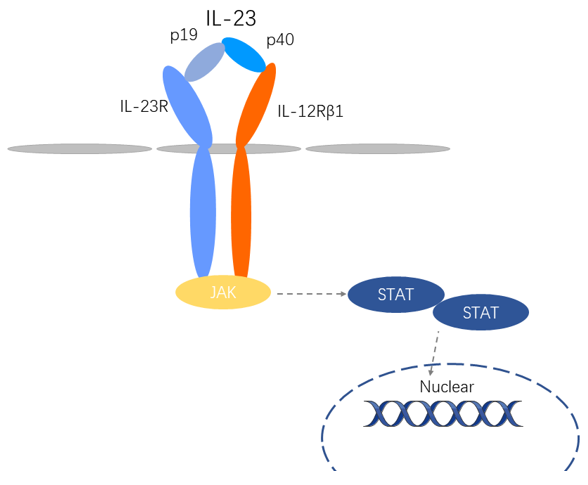Introduction
IL-23 is a member of the IL-12 family. It has two subunits, p19 and p40, and it is a heterodimeric molecule. It can be produced by many tissues and cells, such as Th1 cells, macrophages, dendritic cells, etc. IL-23 mainly acts as a pro-inflammatory factor. It mainly acts on memory T cells, having the effect of influencing the immune response and potential anti-tumor and anti-infection effects.
Mechanism and Function
The receptor of IL-23 is composed of two subunits of IL-12Rβ1 and IL-23R. IL-12Rβ1 mainly binds to the p40 subunit and is mainly expressed on T cells, NK cells and dendritic cells, while IL-23R It mainly binds to the p19 subunit and is only expressed on T cells, NK cells, monocytes and dendritic cells. IL-23 can only conduct signal transduction in the above cells. IL-23 binds to its receptor for signal transduction, activates JAKs, and phosphorylates the STAT binding site in the receptor cell. STAT molecules aggregate in the form of dimers, and then JAKs phosphorylate them. Phosphorylated STAT enters the nucleus and has an effect on gene transcription.
IL-23 can enhance cellular immunity by increasing lymphocyte proliferation, inducing IFN-γ production, and promoting dendritic cells to secrete Th1 cytokines. IL-23 also has a certain pro-inflammatory effect. It can stimulate the proliferation of CD4+ T cells through the JAK-STAT pathway, and chemotactic aggregation and migration of inflammatory cells. It also allows dendritic cells and monocytes to produce IL-1 and tumor necrosis factor (TNF) to participate in the innate immune response. IL-23 is abundantly expressed on natural killer T cells and participates in its structural composition. Natural killer T cells produce IL-17, IFN-γ, IL-4 and other cytokines through IL-23 receptors and T cell surface pathways to play the role of innate immunity and adaptive immunity. IL-23 affects many diseases. It plays a key role in autoimmune diseases. It promotes autoimmune arthritis and is the main promoting factor in the end-stage of autoimmune arthritis. It has a certain effect on inflammatory enteritis. It can promote the secretion of IL-17 by Th17, and further induce T cells, fibroblasts, endothelial cells and macrophages to produce a variety of pro-inflammatory factors, thereby causing intestinal damage. It also plays a role in bronchial asthma. IL-23 can induce the secretion of Th2 cytokines and the accumulation of eosinophils, thereby aggravating the disease. In Klebsiella pneumoniae infection, IL-23 can induce IL-17 to play a defensive role against the host of the bacteria. In B. pertussis infection, IL-23 can also resist the intracellular B. pertussis. IL-23 also has a certain relationship with tumors. It makes CD4+ T cells produce IL-17, which leads to the recruitment of a series of inflammatory cells, promotes inflammation, and up-regulates the activity of matrix metalloproteinase-9. It also promotes angiogenesis, and provides a protective environment for tumors. But it is an effective preventive mechanism for bacterial infections. However, excessive IL-23 can induce CD8+T cytotoxic T cells and natural killer cells, and activate CD4+T cells to exert anti-tumor immunity. In pancreatic cancer, it can exert anti-tumor effects in a non-NK cell dependent manner. It can also fight tumors by increasing the level of IFN-γ in brain tissue.
 Fig 1. Mechanism of Signaling
Fig 1. Mechanism of Signaling
Creative Proteomics can provide cytokine detection platform for scientific research. According to different purposes, our dedicated analysts will customize exclusive solutions for you. We aim to provide customers with high-quality and convenient services to help you accelerate the progress of your project.
Our cytokine detection service includes but is not limited to:
- Quantitative and qualitative detection of cytokines in different species
- Quantitative and qualitative detection of cytokine antibodies
- Quantitative and qualitative detection of single/mulltiple cytokines
Sample requirements
- Sample Types-Blood, serum, plasma, cerebrospinal fluid, cell culture supernatant, tissue homogenate, cell culture medium, urine, tumor, etc.
- Sample Volume-It is optimal for at least 200µl of each sample. This volume allows for triplicate testing of each sample.
Our advantages:
- Efficient design: Multiplex reaction detecting in various methods are available, which can be selected according to different samples and requirements.
- Sensitive detection: High-quality antibodies are used in the detection process to improve detection specificity and accuracy.
- Reliable results: The feedback results are professional and efficient.
Technology platform:
We mainly provide the Luminex cytokine detection platform. Luminex uses fluorescently encoded microspheres with specific antibodies to different target molecules. The different microspheres can be combined freely to a certain extent so that up to 100 analytes can be tested multiple times simultaneously in a single experiment.
The Luminex cytokine assay platform has the following advantages:
- Multiple detection: simultaneous detection of 100 biological targets
- Short experiment time: 1-3 weeks
- High sensitivity: the lower limit of accurate quantification is as low as 0.1 pg/mL
- Save samples: only need a sample volume as low as 25 μL
- Time saving: the experiment process only takes 4 hours
For your different needs, we can also provide the following detection methods:
- Enzyme-linked immunosorbent assay (ELISA)
- Flow cytometry
Workflow

For more information about the IL-23 detection service or need other detection requirements, please contact us.
References:
- Langrish, C. L. IL-23 drives a pathogenic T cell population that induces autoimmune inflammation. Journal of Experimental Medicine, 2005, 201(2):233-240.
- Zhou L, Ivanov I I, Spolski R, et al.IL-6 programs T(H)-17 cell differentiation by promoting sequential engagement of the IL-21 and IL-23 pathways. Nature Immunology, 2007, 39(9):967-974.



